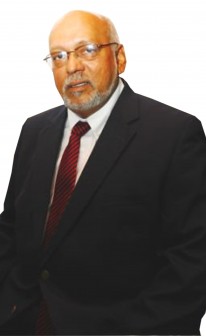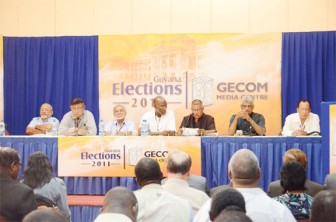The incumbent PPP/C has won enough votes in the general elections to keep the presidency, but will lead a minority government after opposition groups APNU and AFC got enough support to scrape a one-seat advantage in the National Assembly.

PPP/C candidate Donald Ramotar will be sworn in as the country’s next president, but his government will be forced to seek opposition support for major spending and to pass laws and it could face a motion of no-confidence that could result in new elections at any time before the end of its five-year term.
The new parliamentary configuration reflects a sea change in Guyana’s politics. Not since 1964, when the UF combined with the PNC to form a government—despite the PPP having the largest single bloc of votes at the time—are two opposition parties in a position to control parliament. Like the PNC then, the PPP/C will need opposition support for an effectively functioning government.
Of the 475,496 eligible voters, Chief Election Officer Gocool Boodoo yesterday announced that 346,717 cast their ballots, of which 4,418 were rejected and 342,236 were counted as valid, with PPP/C getting 166, 340, APNU 139,638, AFC 35,333 and TUF 885. With 48.6% of the valid votes counted, the PPP secured 32 seats, followed by APNU with 40.8% of the votes and 26 seats, AFC with 10.3% of the votes and seven seats and TUF only managing 0.2% of the votes and failing to capture a seat for the first time.
The turnout was measured at 72.9%, which represents a rise over the 68.82% recorded at the last elections in 2006, but is still significantly lower than the turnout for elections since 1992. A high turnout had initially been estimated by elections observers.
The PPP/C, which lost four seats, would have needed another 5,265 votes from the spoilt ballots or from other parties to notch a majority, but eventually withdrew its requests for recounts of votes after it was accused of delaying the announcement of results.
Although the party chalked up its fifth successive victory at the polls since 1992, this is the first time the party has fallen below 50% in the vote count and the results point to a continuing decline of support since 2001. The party lost 17,000 votes from 2006, and 44,000 from its showing in 2001. In District 6, which is a key stronghold for the party, it received almost 10,000 less votes than it did in the last elections.
A combination of apathy and disaffection with the party is thought to have contributed to the decline in support, some of which has migrated to the AFC. Party stalwart Moses Nagamootoo joined the AFC shortly before nomination day and waged an intense campaign against the PPP/C leadership, which he accused of corruption and departing from the ideals of founder Dr Cheddi Jagan.
The campaigns by the opposition parties targeted the PPP/C and outgoing President Bharrat Jagdeo over government corruption, including questionable deals with investors, alleged links between the administration and convicted drug lord Roger Khan and its poor national security record.
Additionally, although Ramotar was selected to be the candidate by the party leadership, prior to that he had a relatively low profile among its supporters. During PPP/C rallies, supporters walked out during his speeches, which were preceded several times by attacks on opponents by President Jagdeo.
The PPP/C yesterday said it was disappointed by the result. It is believed that the party spent hundreds of millions on the campaign and it has also been accused of using state resources to bribe voters, including handing out flood relief from its party’s headquarters at the start of its election campaign in Lethem, in District 9, which it did win by a majority.
‘Opposition gains’
The PPP/C decline was also due to gains made by the opposition APNU and AFC, which managed a combined 32,000 more votes than the PNCR-1G and AFC in 2006.

Led by retired Brigadier David Granger, APNU recorded a gain of about 25,000 votes over the support that Robert Corbin received in 2006, when he led PNCR-1G to the polls as the largest opposition bloc. APNU also gained four more seats than the PNCR-1G. The main opposition party is the largest constituent of APNU, which also counts WPA, GAP, NFA, JFAP, as partners along with other smaller groups. Among the partners, GAP was the only one that had won a seat in the last elections, which it got in an alliance with ROAR.
Although Granger held a senior position in the army under the PNC administration, he had a relatively low public profile prior to declaring his bid to lead the PNCR and later APNU to the polls. With running mate Rupert Roopnaraine of the WPA, Granger campaigned with APNU partners for a unity government, while promising a safer country and to reform the education system to ensure a future of young people.
In districts 3, 4, 7, 9 and 10, APNU posted significant gains over the PNCR-1G’s results in the last elections, with an increase of over 3,000 votes in District 3, over 16,000 in District 4 and over 4,000 in District 10. It is believed that the PNCR-1G lost support in districts 3 and 10 to the AFC in 2006 and the latter saw reduced numbers in both districts this year. District 4 also saw turnout by voters up by around 10,000 than in the last elections. In District 10, a former PNC stronghold, APNU picked up the support of a PNCR-breakaway group Guyana Youth Congress (GYC), ahead of the nominations, although it is unclear what impact this had on the final count.
The AFC, which opted to go to the polls on its own, increased its tally by just under 7,000 votes and gained two seats in the process. Like in 2006, the party campaigned on a “change” platform, in which it marketed itself as a vehicle to end racial voting patterns. In keeping with a rotation principle adopted by the party, 2006 running mates Khemraj Ramjattan and Raphael Trotman led the party to the polls, as the presidential and prime ministerial candidates, respectively, this time around.
The AFC did face doubts over Ramjattan’s ability to maintain the party’s support base, in District 4, in particular—where it was believed that former PNCR MP Trotman had managed to attract supporters—and in District 6, where it polled poorly in 2006. The AFC also faced some criticism for its decision against joining the coalition with the PNCR and other parties.
Despite the loss of votes in districts 4 and 10, AFC saw significant gains in both districts 5, and 6, managing over 8,000 more votes in the latter, where both Ramjattan and Nagamootoo had strong support.
‘Compromises’
The first challenge for the new government will be the election of a speaker when parliament convenes, which will require a candidate who would be acceptable to one of the two opposition groups.
With control of the parliament, APNU and AFC could promote their respective legislative agendas in exchange for offering support to the government in relation to the budget, supplementary allocations and the passage of laws. The scenario could see the parties work together on a common legislative programme or make compromises on priorities, while also creating greater scope for the work of parliamentary committees, which would no longer be subject to any one party’s control.
Under the constitution, the new president could, however, refuse to assent to legislation passed by the opposition-controlled parliament. Only in a case where a two-thirds majority of elected members of parliament resolve that a bill should be given assent is the president required to act after an initial refusal.
However, prior to the elections, former Speaker of the National Assembly Ralph Ramkarran told this newspaper that in a scenario where the PPP/C won without a majority, the opposition could even force the president to appoint an opposition cabinet if he wanted to survive. Under the Westminster system, he explained, the government has to have the support of the majority of the members of the National Assembly or else it would fail.
The law allows the opposition to move a vote of no-confidence in the government. Article 106 of the constitution says that the cabinet, including the president, shall resign if the government is defeated by a majority of all the elected members of the National Assembly on a vote of no confidence, with elections then due in three months.
Both Roopnaraine and Trotman, in past interviews with Stabroek News, detailed the APNU and AFC positions on the possibility of a minority government and a hung parliament. Roopnaraine, who has long been an advocate for constitutional reform, said that in the case of a minority PPP/C government, it would be foolhardy of the party not to negotiate with the other parties in parliament. In such a scenario, he said that he would urge the establishment of a government of national unity.
Trotman, meanwhile, stipulated that the AFC would not be prepared to enter into any discussions with any other party unless all the parties were invited. There must be a commitment to major constitutional reform that dismantles the executive presidency and which realigns the National Assembly into “its proper orbit of being the people’s representative body,” he said, while adding that the AFC would also want a commitment to tackle corruption, crime and lawlessness.
Both APNU and the AFC have also made it clear that they want the president’s pension package revisited and controversial deals like the Amaila hydropower project reviewed. They have also taken similar positions on the need for full investigation of alleged links between the Jagdeo administration and the drug lord Khan.
The possibility of further constitutional change also looms large as both groups have campaigned against the immunities in place for the president and the need for the completion of the constitutional reform process.




